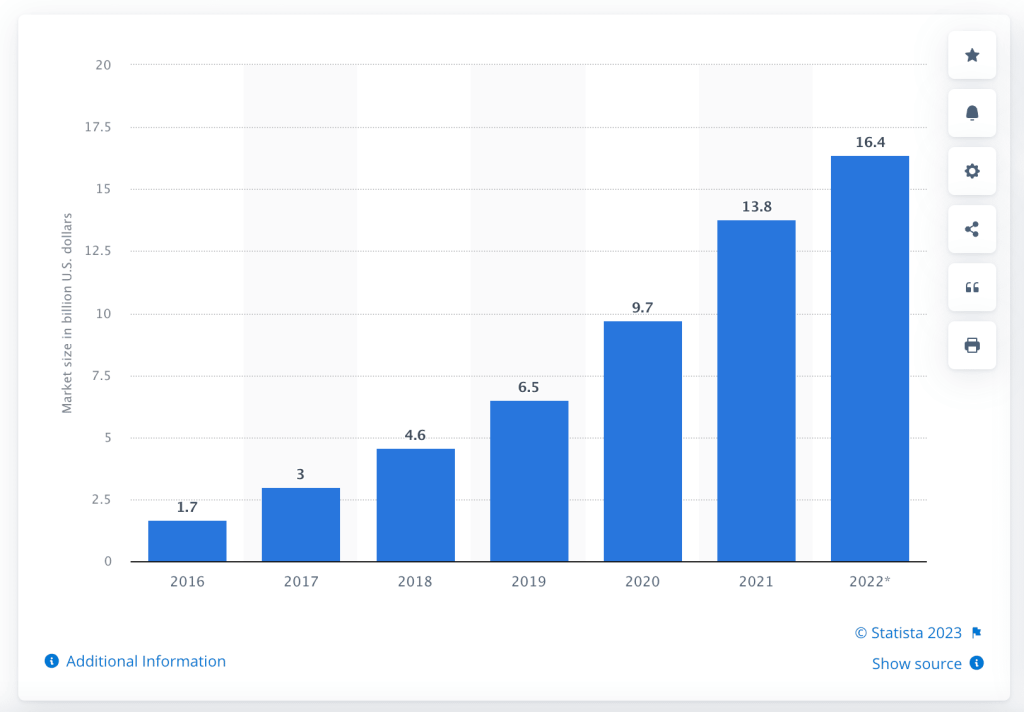
Are you wondering how big the influencer marketing industry is and why it’s growing so rapidly? Well, you’ve come to the right place. In this blog, we will explore the influencer marketing industry and uncover the reasons for its rapid growth.
What is Influencer Marketing?
Before we dive into the growth of the industry, it’s important to first understand what influencer marketing is. Influencer marketing is a way of using influencers as part of a marketing strategy to promote a brand, product, or service. It leverages the fact that influencers often have the power to shape public opinion, drive consumer behavior, and generate brand awareness. Influencers have the ability to reach a large audience with their content and have a powerful impact on their followers.
Influencer marketing can be done by brands gifting influencers products, sponsoring their social media posts, striking ambassador deals, and more.
Typically, influencers are identified through social media channels such as Instagram, YouTube, and TikTok. They often have a large following (although different follower counts equate to different types of influencers) and are seen as experts in their field. Working with influencers to promote products to their followers, brands are relying on the idea that their target audience will be more likely to make a purchase due to the influencer’s connection with their followers, high engagement rates, and impact.

The Rise of Influencer Marketing
The influencer marketing industry has been gaining momentum over the past decade, and it’s no surprise why. In today’s digital world, consumers are increasingly turning to social media for advice, recommendations, and inspiration. By partnering with influencers, brands can tap into this, as well as influencers’ large and engaged audiences, to reach their target customers more effectively.
Furthermore, influencer marketing is more cost-effective than traditional forms of advertising. This is down to a few reasons:
- Lower production costs: influencers produce their own content in their own style and environment so brands don’t need to pay extra for photographers, creative directors, location, or other costs associated with traditional ad shoots. Often, influencers use their phones to produce their content.
- Higher engagement rates: influencer content tends to bring higher engagement than content posted by brands directly. This is due to the fact that influencers have built up a relationship with their audience based on shared interests, so their audience will actively want to keep up with what they are posting. The higher the engagement rate on a piece of content, the more brand awareness, traffic and lead generation it will create, ultimately leading to increased conversions on the product or service being promoted. In fact, 33% of Gen Z-ers have bought a product based on an influencer’s recommendation in the past three months.
- Increased trust: similarly, the relationship built between influencers and their audience is often based on trust. Social media users follow influencers they feel are authentic and reliable. So, if one of their trusted influencers recommends a product, they’re more likely to buy it. Which means more revenue for the brands behind the product. According to Hubspot, 50% of Millennials trust influencer product recommendations – that’s a lot!
How Big is the Influencer Marketing Industry?
The influencer marketing industry is estimated to be worth over $13 billion, and it’s growing rapidly. According to a survey by Statista, the influencer marketing market size was estimated to be $16.4 billion in 2022 and is projected to grow to $143 billion by 2030.

How and Why is Influencer Marketing Growing?
There are a number of factors contributing to the growth of the influencer marketing industry. One of the key drivers of this growth is the increasing number of influencers on social media. As mobile phone and social media users grow globally, it’s only natural that the number of influencers will follow suit. With more social media users out there, these influencers also have more chances of building a bigger audience and creating successful campaigns for brands, fueling the growth cycle.
Additionally, the growth of the influencer marketing industry is being driven by the rising popularity of influencers, as well as the increasing number of brands partnering with influencers. In fact, 72% of Gen Z and Millennials follow influencers on social media according to Hubspot, and 1 in 4 marketers currently leverage influencer marketing.
Influencer Marketing Trends 2023
It’s important to note that there are a number of key trends that are shaping the influencer marketing industry. One of these trends is the shift from macro-influencers to micro-influencers in both consumer popularity and brand preference. Micro-influencers are individuals with a smaller following compared to macro-influencers, but they tend to have higher engagement rates and are often seen as more authentic and relatable to their followers. This has led to an increase in the number of brands partnering with micro-influencers.
This leads perfectly onto another important trend, which is the increasing focus on authenticity on social media. As the influencer marketing industry continues to grow, brands are increasingly looking for authentic influencers who are relevant to their product or service. Otherwise, the partnership would look inauthentic. For example, a recipe meal kit service would likely see better results when collaborating with a lifestyle or food influencer as opposed to a travel or gaming influencer.
This has led to an increase in long-term partnerships between brands and influencers, because the more authentic the partnership, the longer it will continue to reap rewards.
Finally, the increasing presence of influencer marketing tools in an era obsessed with data and analytics is also driving the growth of the influencer marketing industry. Brands are using data and analytics to measure the effectiveness of their influencer marketing campaigns and target the right audiences more efficiently. Influencer marketing tools that have become incredibly popular include SproutSocial, Upfluence, Klear, and Pitchbox. They allow brands to easily track and measure the performance of their campaigns, automate and streamline processes, and use business intelligence to drive campaigns.
The future of the influencer marketing industry looks promising. Society’s rising focus on sustainability will play a big part in the growth of the influencer marketing industry. Brands are now looking for influencers who are passionate about sustainability and are able to connect with their target audiences on this issue.

Conclusion
In conclusion, the influencer marketing industry is growing rapidly and is estimated to be worth around $143 billion by 2030 (growing from $16.4 billion in 2022). This growth is being driven by numerous factors, including the increasing number of influencers on social media, the increasing number of brands partnering with them, and a societal shift towards consuming authentic and more sustainably oriented content.
What’s more, with the plethora of influencer marketing tools out there, brands can now measure the effectiveness of their influencer marketing campaigns using data and analytics, just as they would do with any of their other digital marketing campaigns.
As the industry continues to grow, it’s important for brands to keep up with the latest trends in order to remain competitive.
FAQs
Yes, influencer marketing is more relevant than ever before. The industry is growing rapidly – it’s projected to be worth $143 billion by 2030. We live in a social media era, and influencer marketing is one of the most effective forms of marketing on social media (and generally).






